Who says you can only enjoy pretty flowers during spring and summer? When the temperature drops, your garden may suffer from neglect and overgrown plants. However, just because the end of summer is near, it doesn’t mean it’s the end of your garden. As the days get shorter, it’s time to brighten up your landscaping, flower beds, and container gardens. All it takes is planting a few perennials and annuals to keep your garden alive through the cold-weather season.
We think Southern gardens show their true colors in fall. Spring may garner much attention from gardening enthusiasts, but fall has a pleasantly surprising array of blooms. Arrange your cold-weather garden with various jewel-tone shades like red, gold, orange, and purple. Don’t believe us? Scroll for a little growing inspiration and a dose of autumnal whimsy.
Get Fired Up
Highlight autumn’s bounty by packing your garden with various plants, such as sedum, purple cabbage, ornamental peppers, Mexican bush sage, and cosmos. The fiery shades of orange and yellow balance the cooler tones of purple and blue in this vibrant container mix. Add colorful stacked pumpkins to take your garden to the next level.
Use Flashy Marigolds
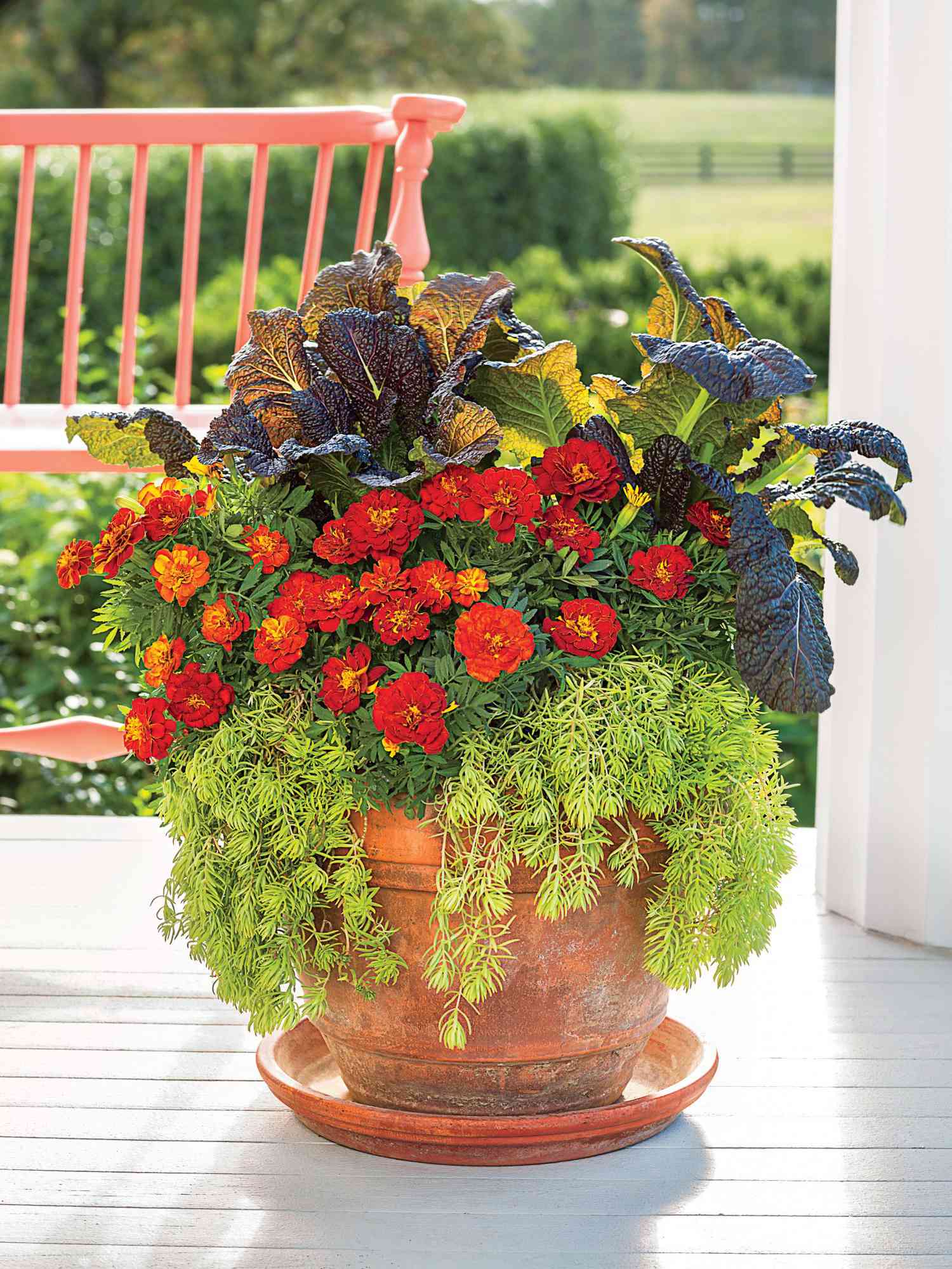
Marigolds (Tagetes spp.) add a splash of bright orange and yellow to container gardens in full sun. Enjoy these hardy blooms throughout summer and fall, often until the first frost. Deadheading will produce more flowers. Add some trailing plants to balance the pops of color and add variety to your containers.
Plant Russian Sage
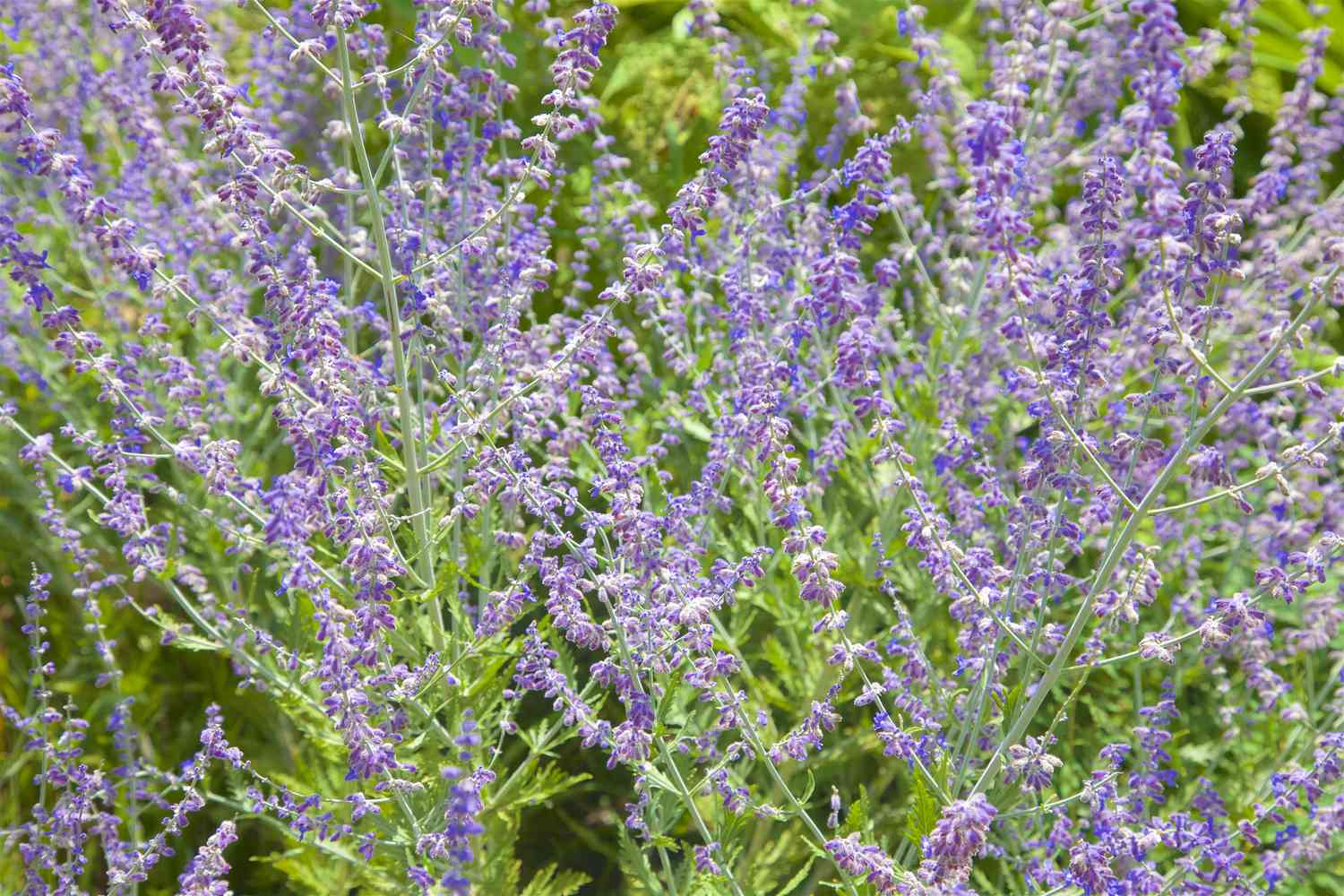
Using Russian sage (Salvia yangii) makes a bold statement in any garden. It’s known for its purple-silvery color and height, which glimmer in the sun and brighten your fall garden. Make sure to have enough room for this plant to grow as it reaches up to 5 feet high and 3 feet wide. Plant it in full sun in well-drained soil in USDA plant hardiness zones 5-9.
Use Decorative Mums
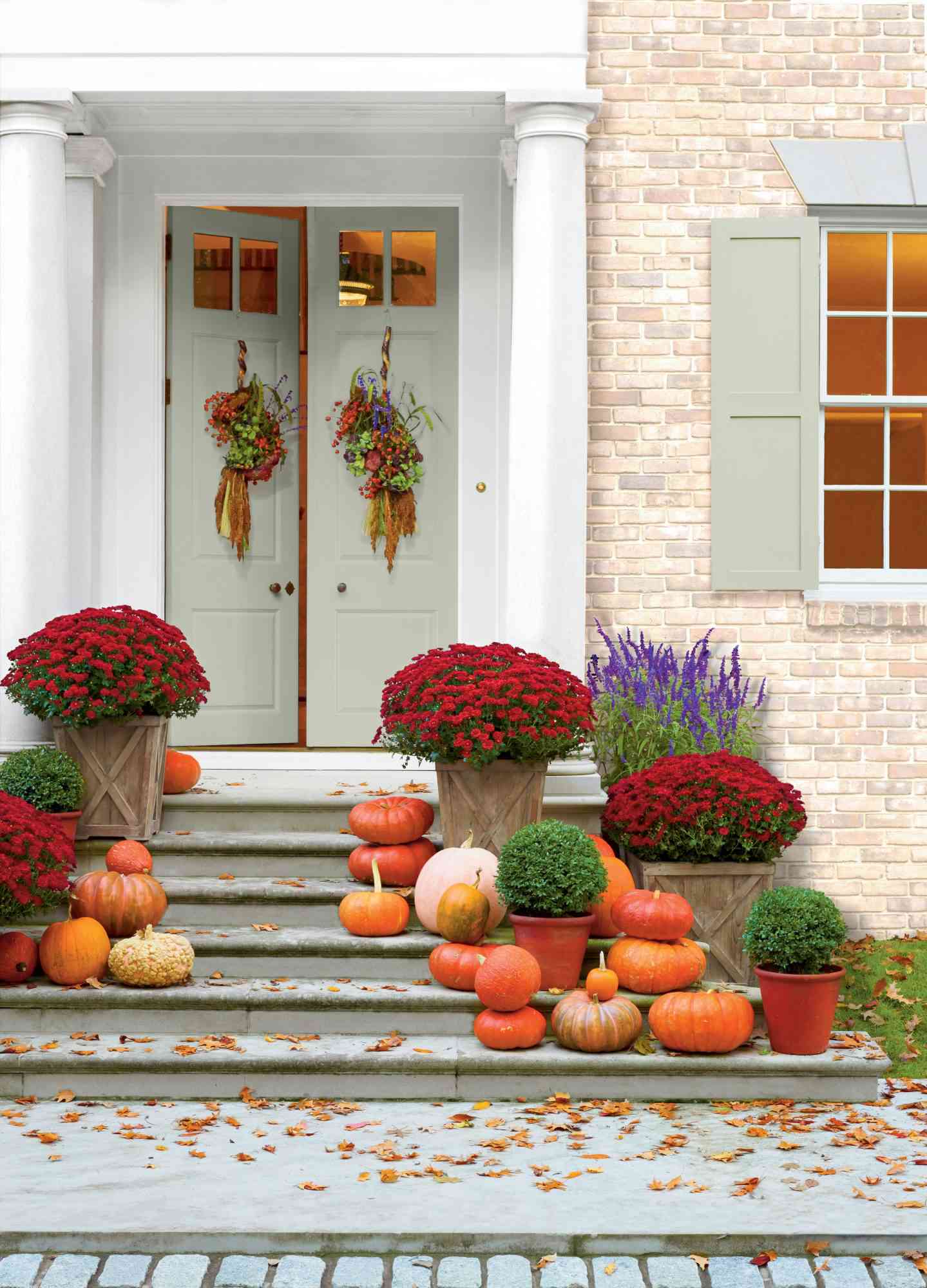
The classic fall combination of mums and pumpkins gives your front entry a warm welcome. This duo brings a feeling of autumnal bliss to mind. Coordinate the color of chrysanthemums with your home’s exterior for a seamless look, or use white pumpkins for a classic twist. For the best bloom, place them in full sun and water frequently.
Brighten With Perennial Sunflowers
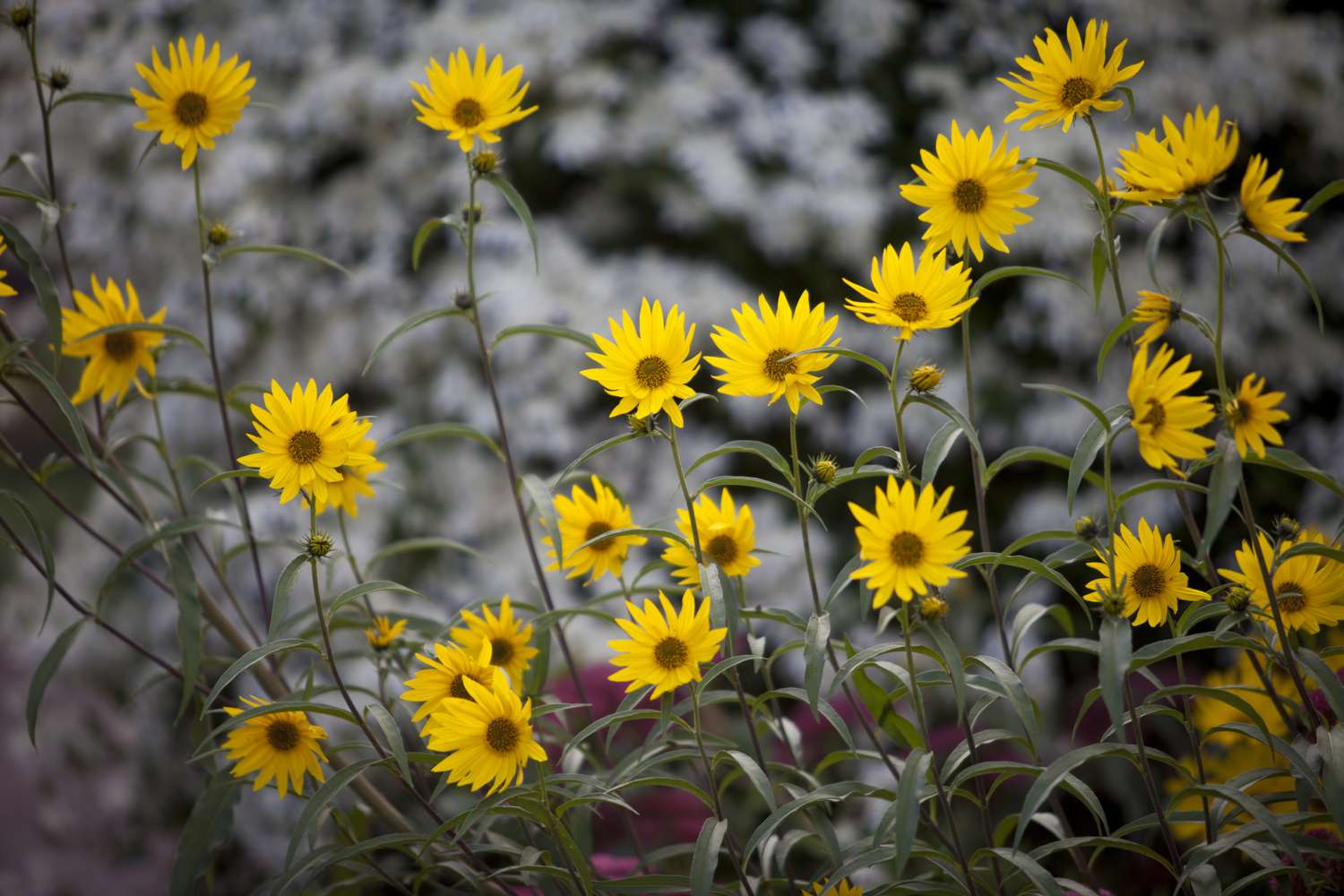
While perennial sunflowers (Helianthus spp.) don’t bear the large flowering heads like their annual counterparts, these long-blooming, daisy-like plants are still just as bright. Plant once and enjoy for years to come. Perennial sunflowers like moist soil and full sun but will adjust to partial shade and average garden conditions.
Fill Containers With Colorful Lantana
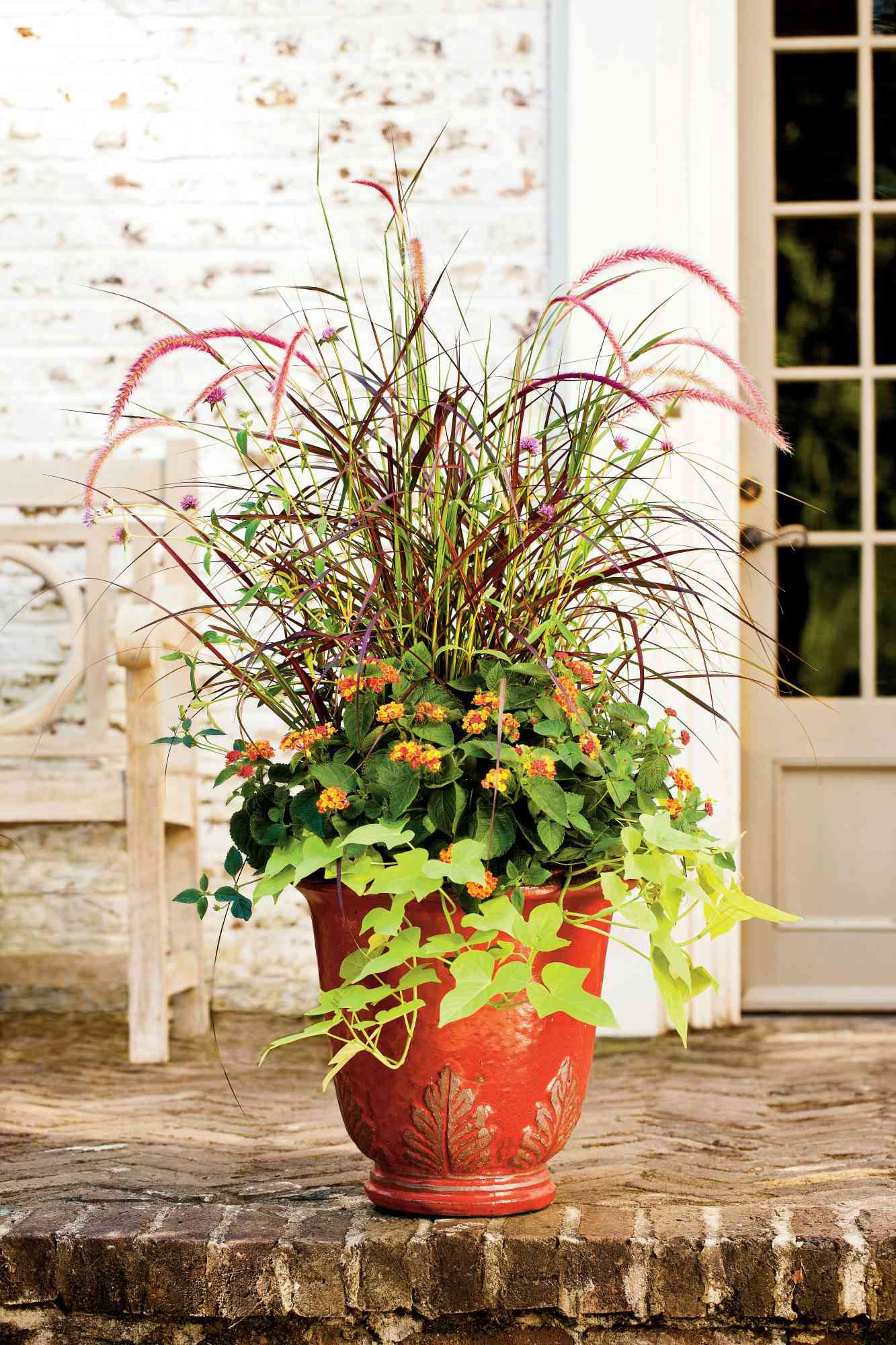
Lantana is a summer and fall-blooming favorite that will reward you handsomely with abundant flowers and many colors this season. Lantanas are relatively drought-tolerant, so they make a good choice for fall gardens when getting outdoors may become less frequent. Thrill, fill, spill your sun-drenched containers with it, as well as fountain grass and sweet potato vines.
Create An Edible Attraction
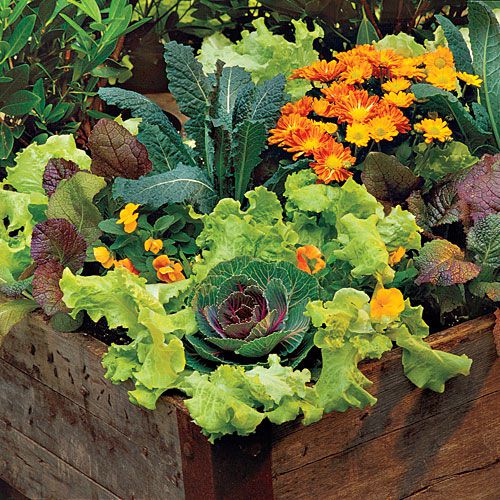
This container garden is a feast for the eyes and the plate since it contains leafy lettuce greens, colorful violas, and fall-inspired mums. Like mums, lettuce requires more regular watering, so keep that in mind for this arrangement. Protect it from hot afternoon sun to keep your greens from bolting.
Mix Coleus And Chrysanthemums
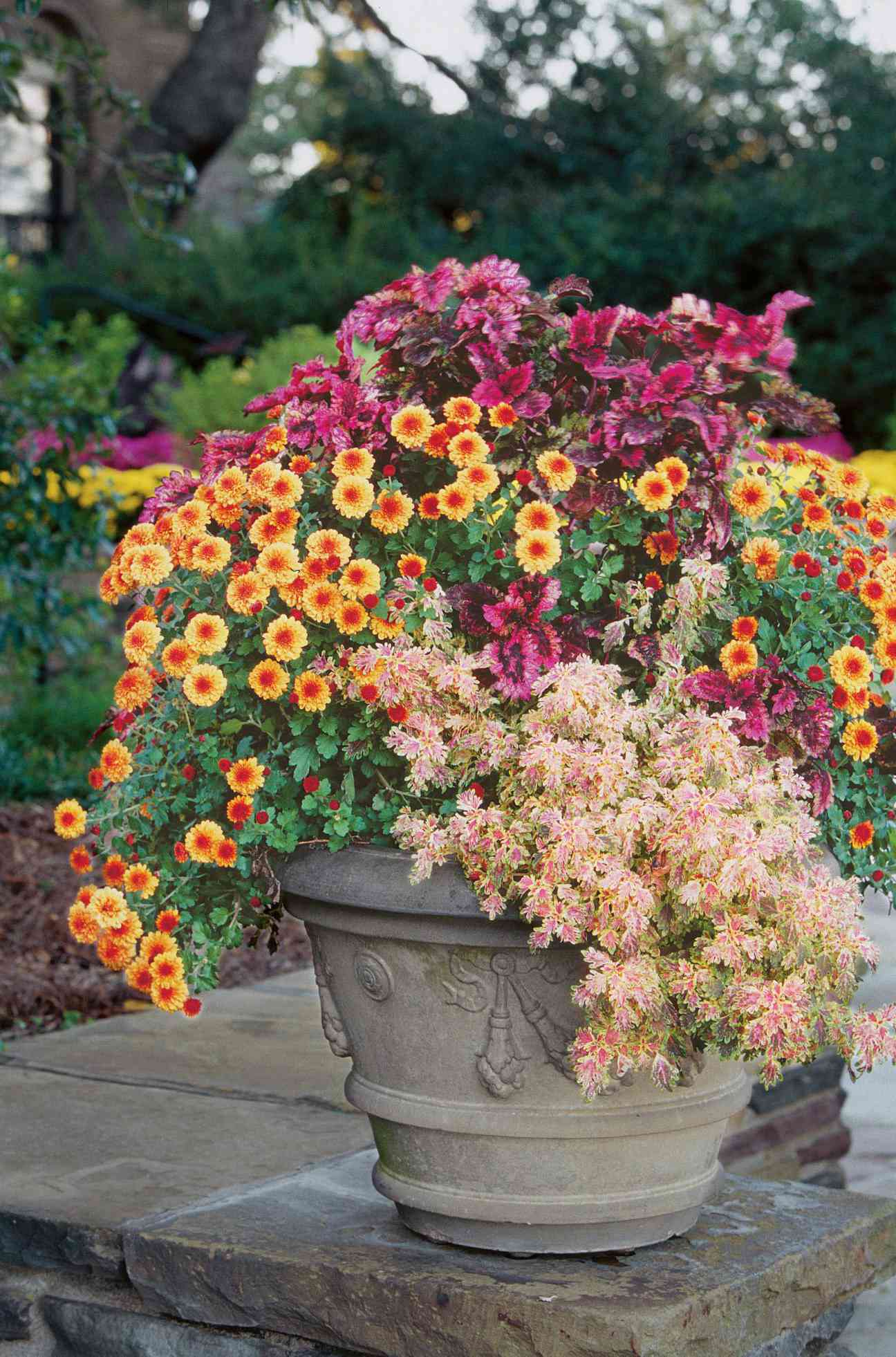
If you could pick any plant for your garden’s grand finale, it should be the official flower of autumn—the chrysanthemum. But mixing in multi-colored coleus foliage will make your containers shine. Coleus usually grow best in partial shade, but look for newer varieties that can tolerate more sun.
Use The All-Star Aster

Plant perennial asters in late summer, and you’ll enjoy a vivid display of blooms in various shades, including blues, reds, pinks, and purples, from mid-September through November. Possibly the best substitute for mums for fall gardens, asters will thrive late in the year as temperatures decrease. Protect them from afternoon sun if your days are still hot and keep soil lightly moist.
Carve Out Mumkins
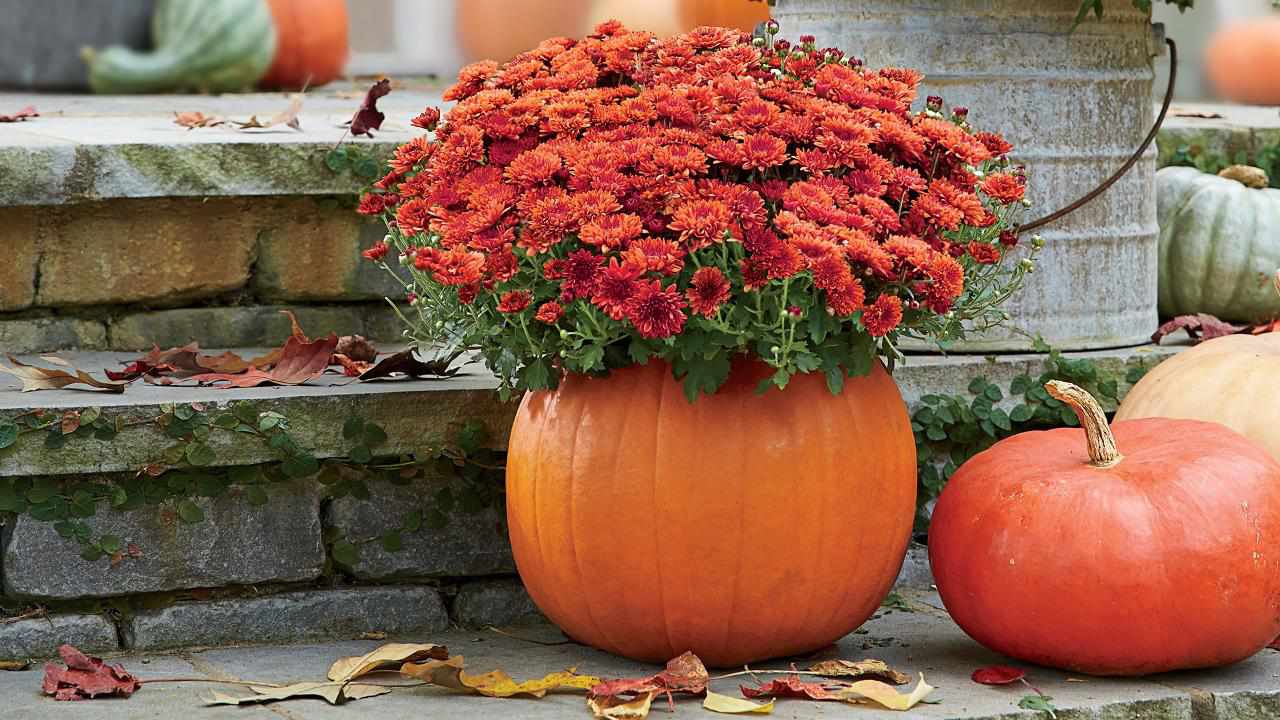
This display is the brilliant result of packing mums inside pumpkins, creating the «mumkin.» Add an autumnal flair to your entryway by stepping up your container arrangement decor in this unique, DIY-style planter. Use this opportunity to complement the orange-colored pumpkins with the various mum hues.
Grow Violas In Stacked Containers
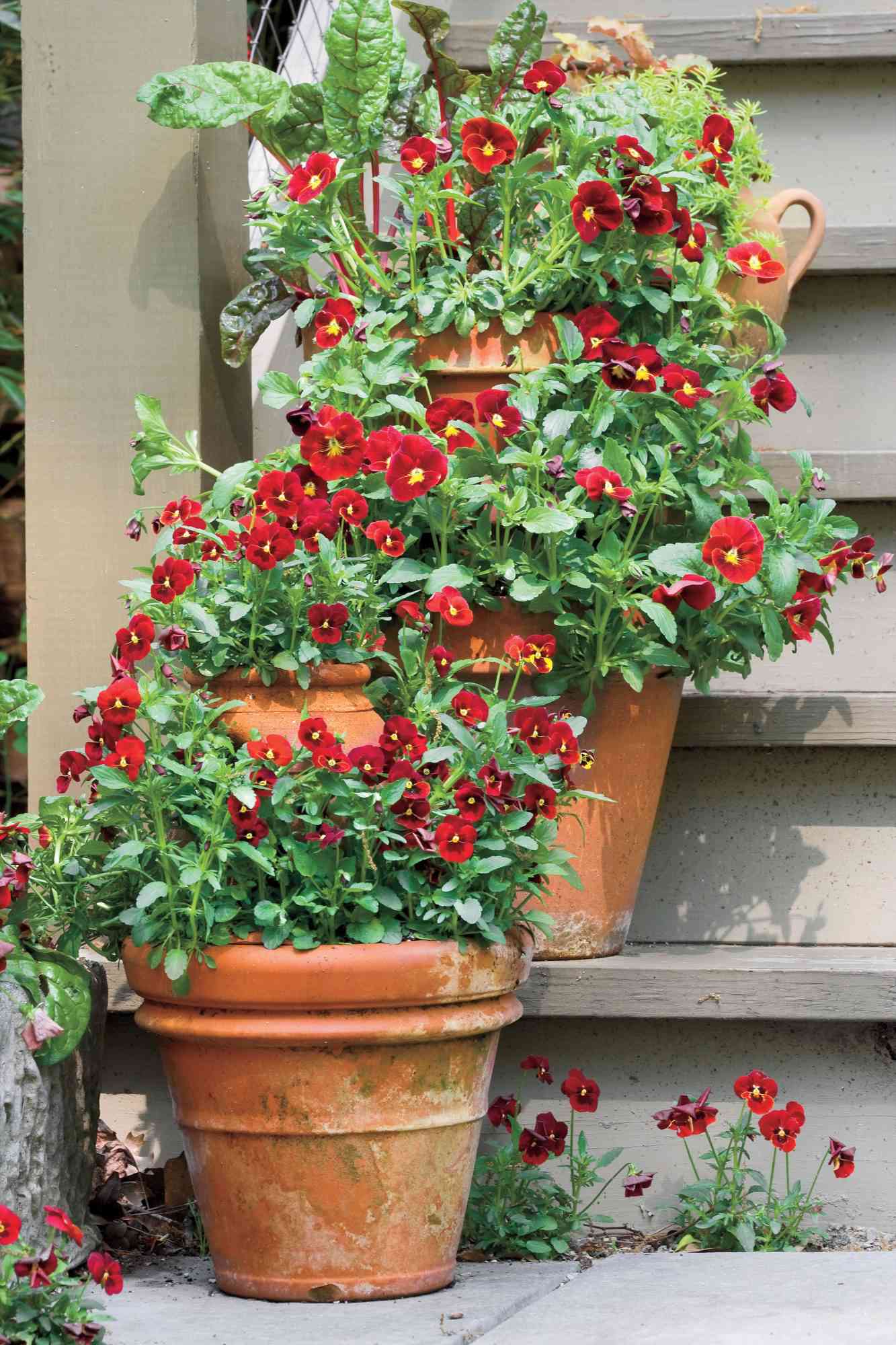
These red viola-filled containers have serious curb appeal. A display like this deserves to be front and center. Stack the containers on your entryway stairs or group them for a clustered arrangement. These cool-season flowers often continue blooming into winter, and can be grown in full or partial sun.
Savor Fragrant Anise Hyssop
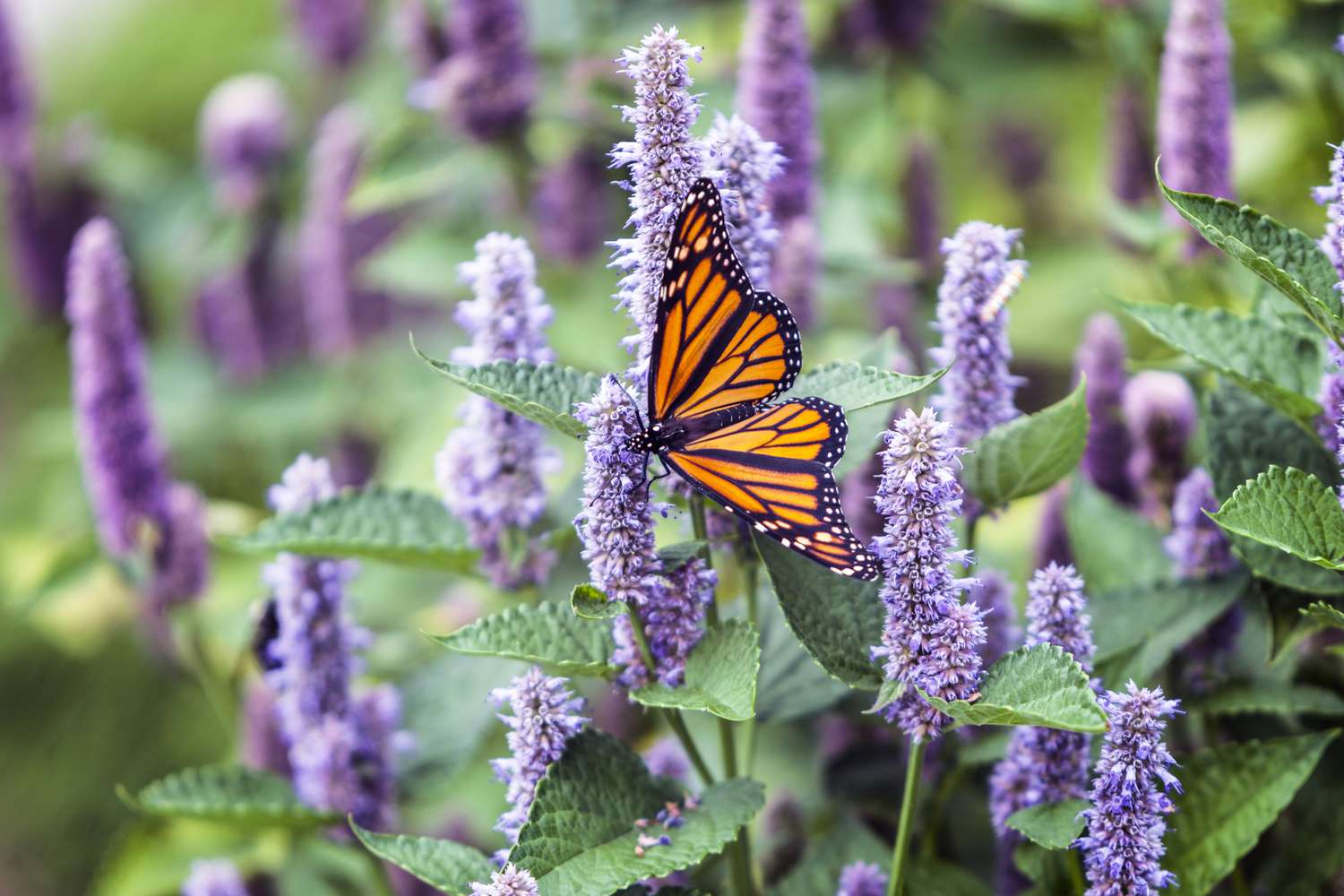
If you haven’t already, you’ll fall in love with wispy anise hyssop. Not only is it a beautiful flower to plant, but it’s also a medicinal herb and aromatic perennial that attracts bees, hummingbirds, and butterflies. This tall plant looks great on its own or alongside a wall or fence. Plant it in full or partial sun in well-drained soil.
Pair Pansies And Evergreens
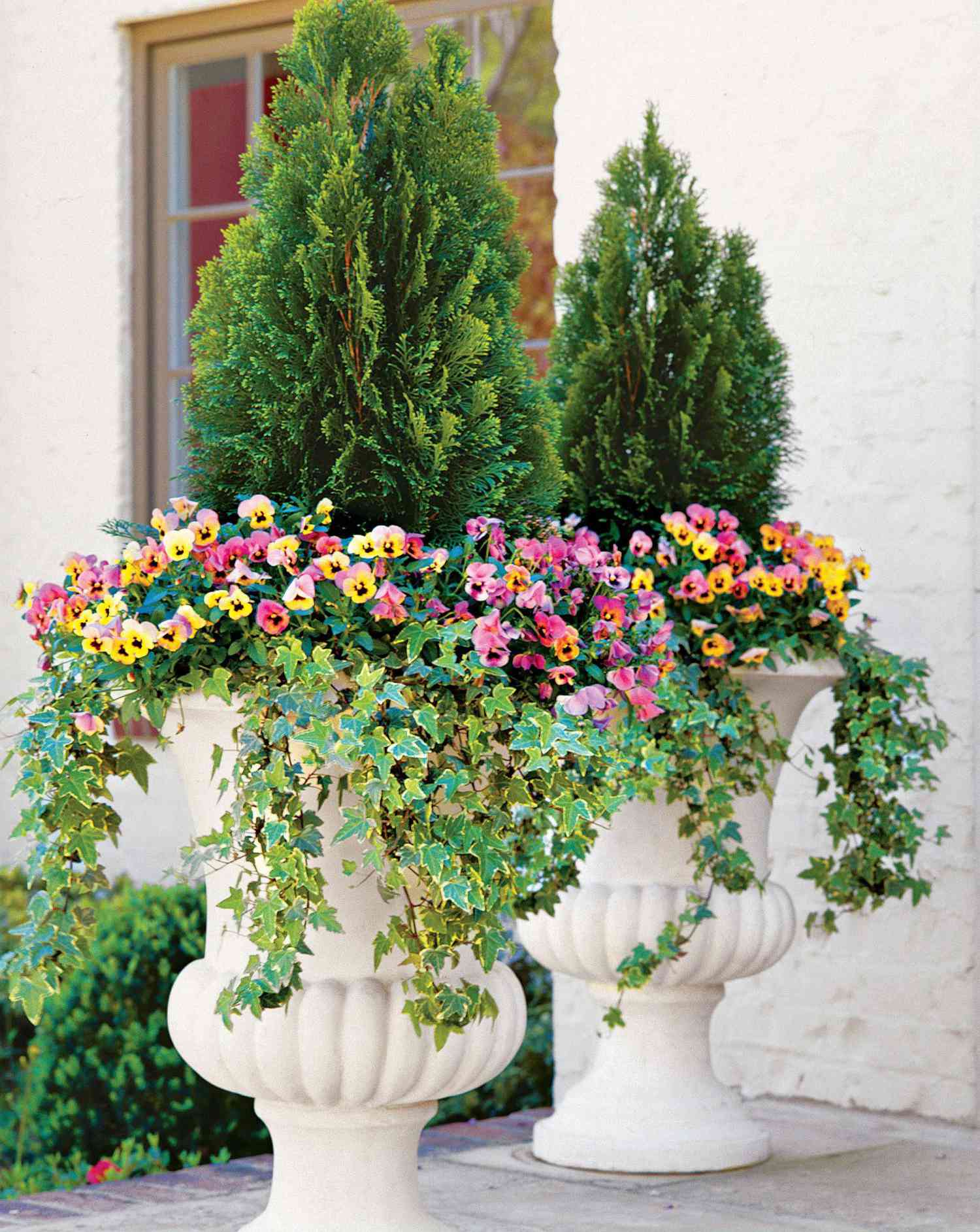
When you grow tired of smaller-bloom violas, try their country counterparts—pansies. These eye-catching flowers will liven up your garden throughout the fall and can last all winter in milder climates. Pansies are great for containers, borders, or ground cover in areas with full or partial sun exposure.
Take Advantage of Calibrachoa
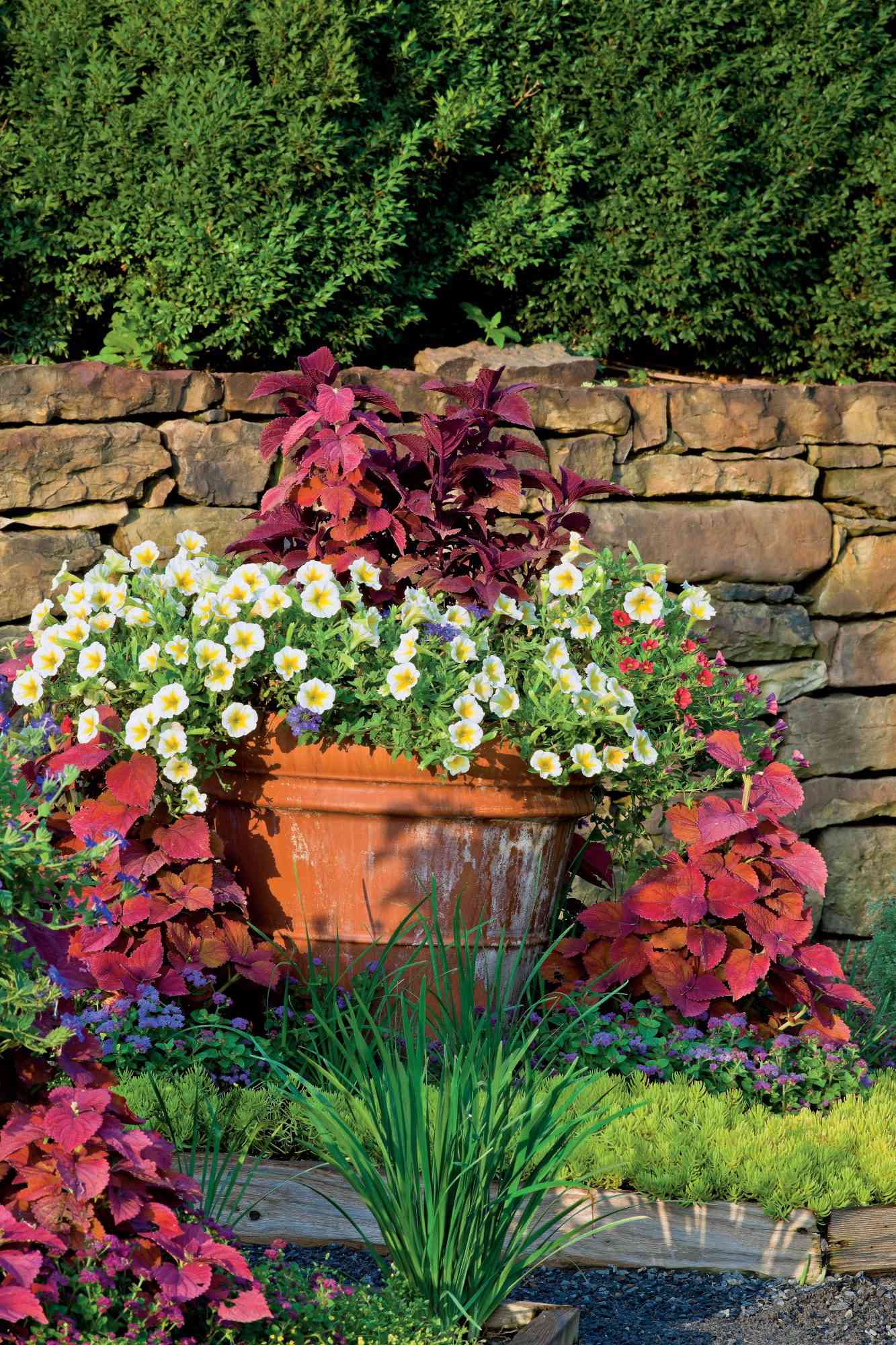
Also known as million bells, calibrachoa’s profuse flowers endure the summer heat and then keep on blooming until frost. In this impressive container garden display, the magenta hues of coleus and sweet potato vine offset the creamy flowers. Calibrachoa performs best in moist, well-drained soil in full sun.
Embrace Multi-Colored Violas

Galvanized buckets filled with violas and creeping Jenny are true garden gems. The spillers add some interest to wherever you place this container. Try using this arrangement in hanging baskets and allow the creeping Jenny to trail to the ground.
Get Sunny With Marigolds
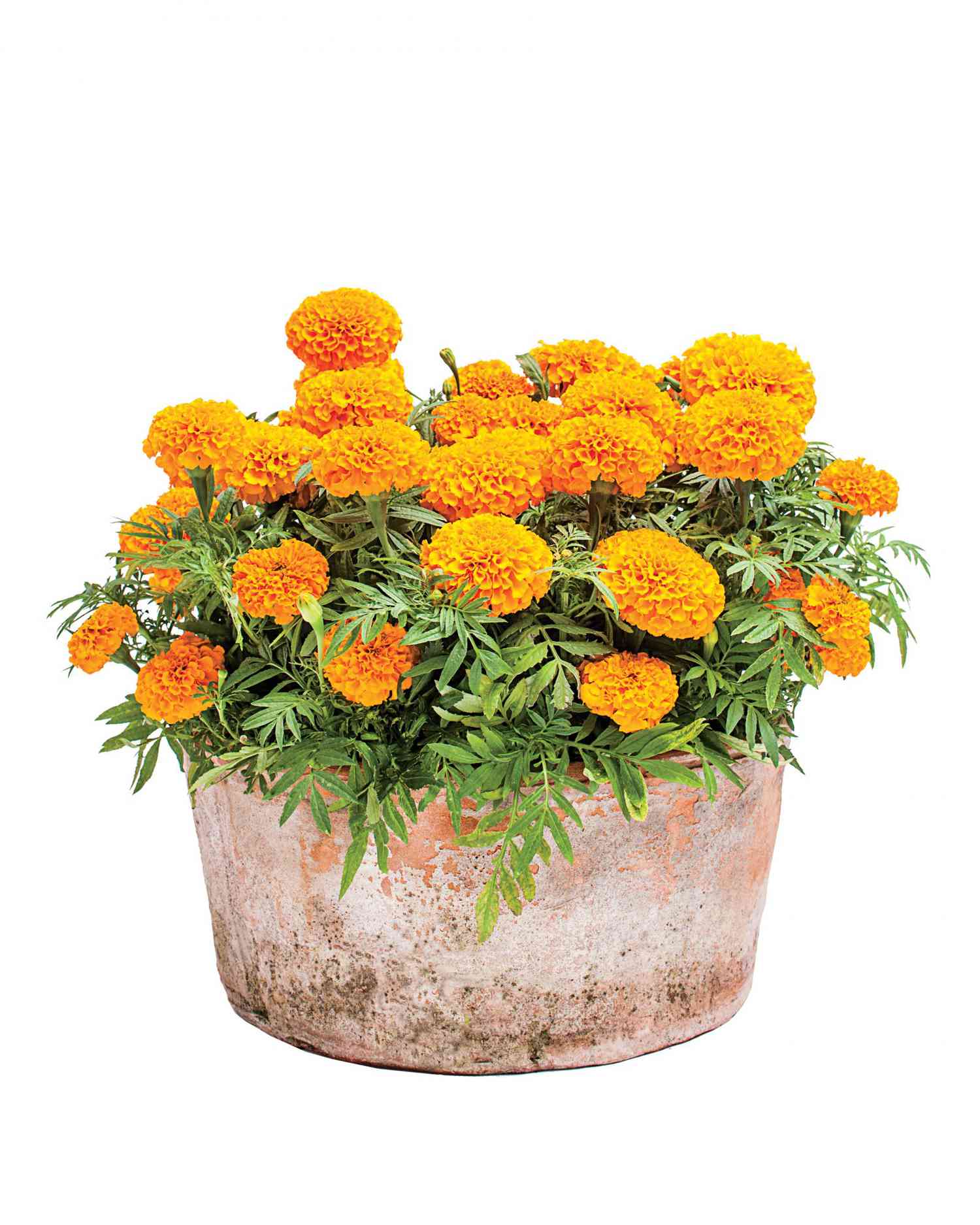
Say hello to this late-season beauty. The autumnal-gold color livens up any fall garden. Despite blooming into the fall, these plants thrive in full sunshine, so make sure to plant in an area that still gets sunlight late in the year.
Plant Autumn Crocus
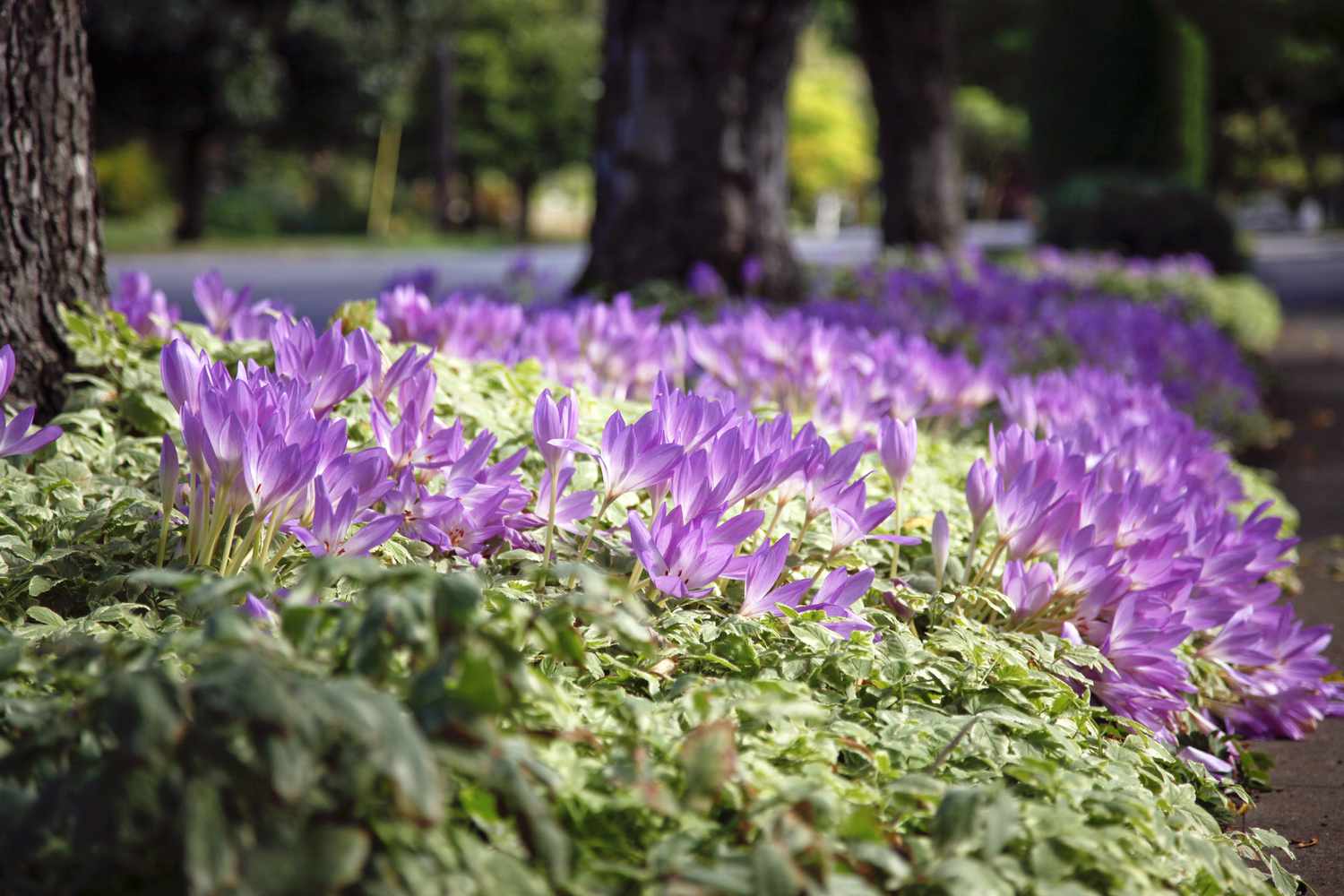
If you’re looking for a fall-blooming bulb, colchicum has a significant wow factor. Colchicum, commonly known as autumn crocus, are toxic to consume, so don’t mistake these for a different edible plant in your garden. Autumn crocus grow well in gravel gardens, so this might be a good plant for borders or walkways.
Light Up The Garden With Heleniums

For vertical height and colorful impact, you can’t go wrong with a cheery border of heleniums in sunny yellows and cinnamon orange. Some varieties of heleniums bloom late in the season, up to the first frost. In addition, they’re also a great deer and rabbit repeller. Plant in full sun and give them plenty of water.
Enjoy Johnny Jump-Ups

No fall garden should be without these petite heirloom violas or, as they’re often called, «Johnny Jump-Ups.» The delicate flower is great as a filler between larger shrubs or under trees. Keep these in areas with at least partial sun.
Arrange Contrasting Classic Mums
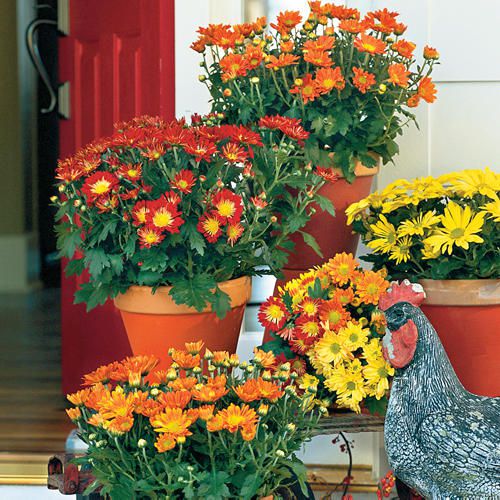
As we said, mums are a classic. This selection of varying mums uses a fall color palette to highlight the season’s best feature—the changing foliage. No matter where your tree’s foliage is in its transition, there is a mum to match.
Feel «Autumn Joy»
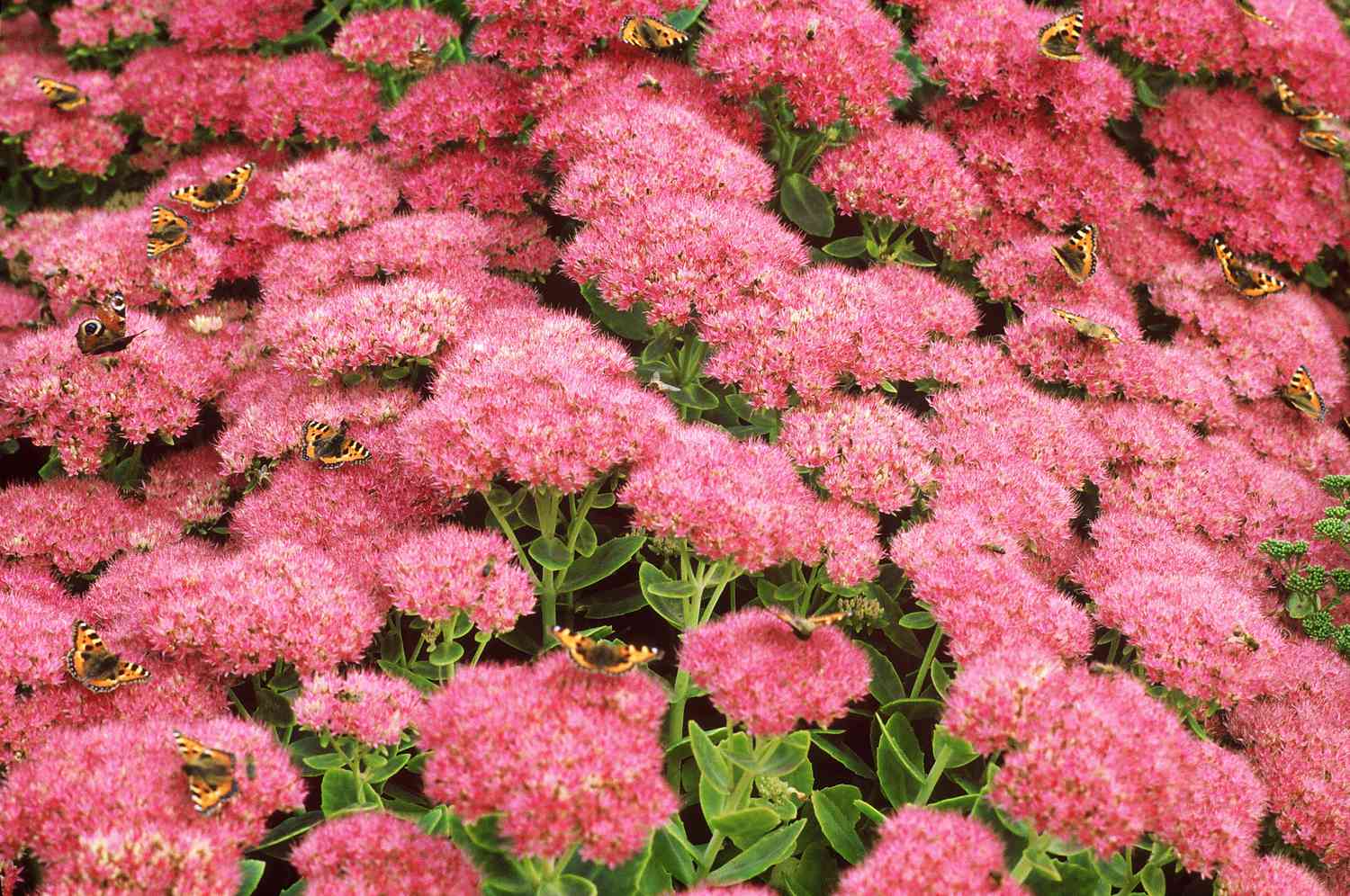
Fall-blooming «Autumn Joy» (Hylotelephium «Herbstfreude») has been popular for decades for a reason. There are many other varieties to choose from today. A late-blooming standout, tall stonecrops and ground-hugging sedums require very little attention and are drought tolerant. Both types offer tiny, colorful flower clusters that attract loads of pollinators.
Underplant Mums With Spillers

Bring a little enchantment and excitement to a rustic planter with mums and foliage. Allow bright foliage to spill over the container, creating an elegant cascading display. Surrounding the arrangement with pumpkins adds an extra dosage of fall scenery to the display.
Feed Birds And Butterflies With Coneflowers

Coneflowers are one of the longest-lasting bloomers and showiest of garden perennials. You and the butterflies will appreciate the purple coneflower’s large rose flowers and rust-colored central cone in late summer and early fall. When coneflowers stop blooming, the bristly seed-heads attract goldfinches and other birds all season long.
Create A Monochromatic Container
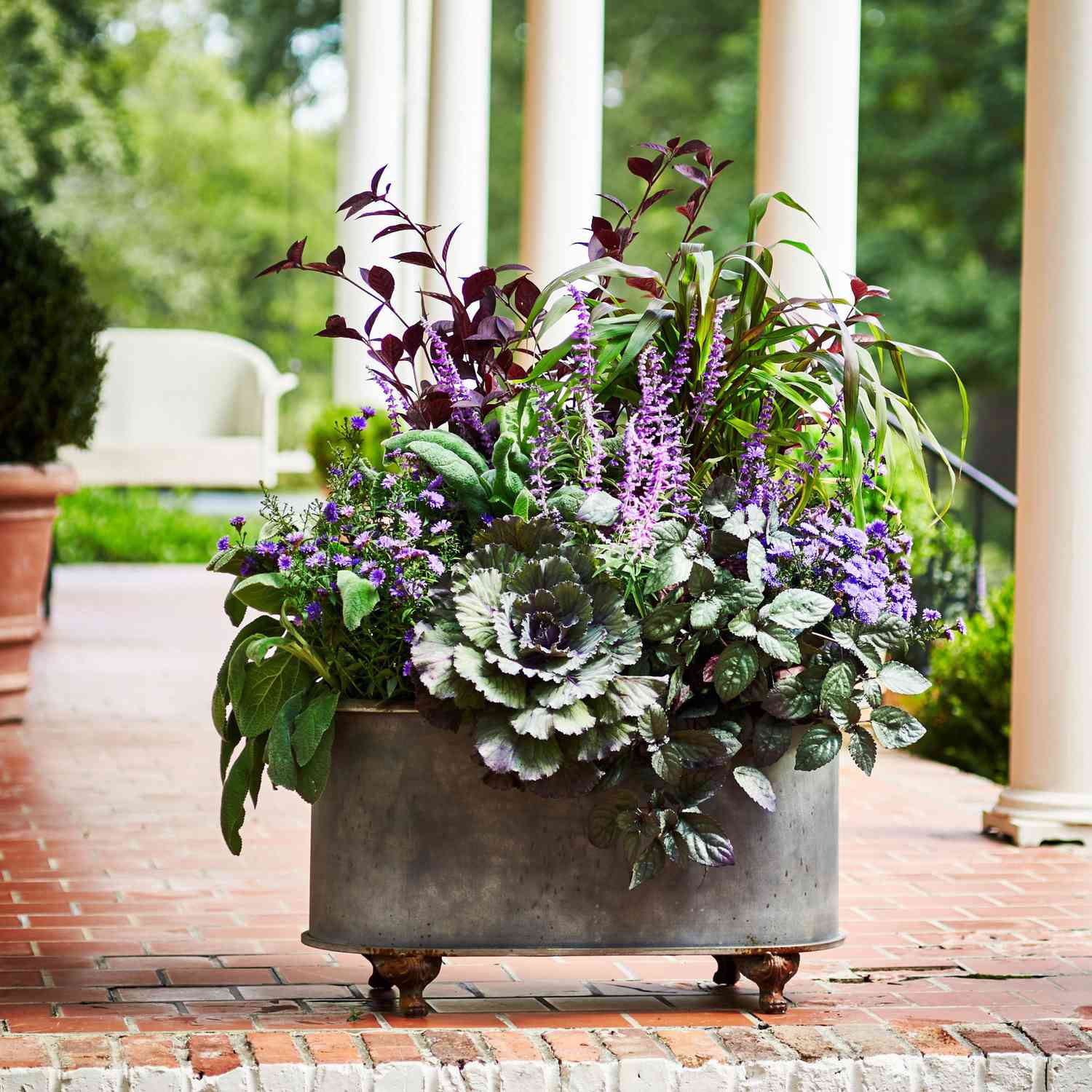
Purple asters mixed with ornamental cabbage, Mexican bush sage, purple waffle plant, lamb’s ears, and «Purple Prince» alternanthera create this moody fall display. Blooming in late summer and early fall, asters can withstand the South’s fickle autumn temperatures.
Fill Pots With Firecracker Flower
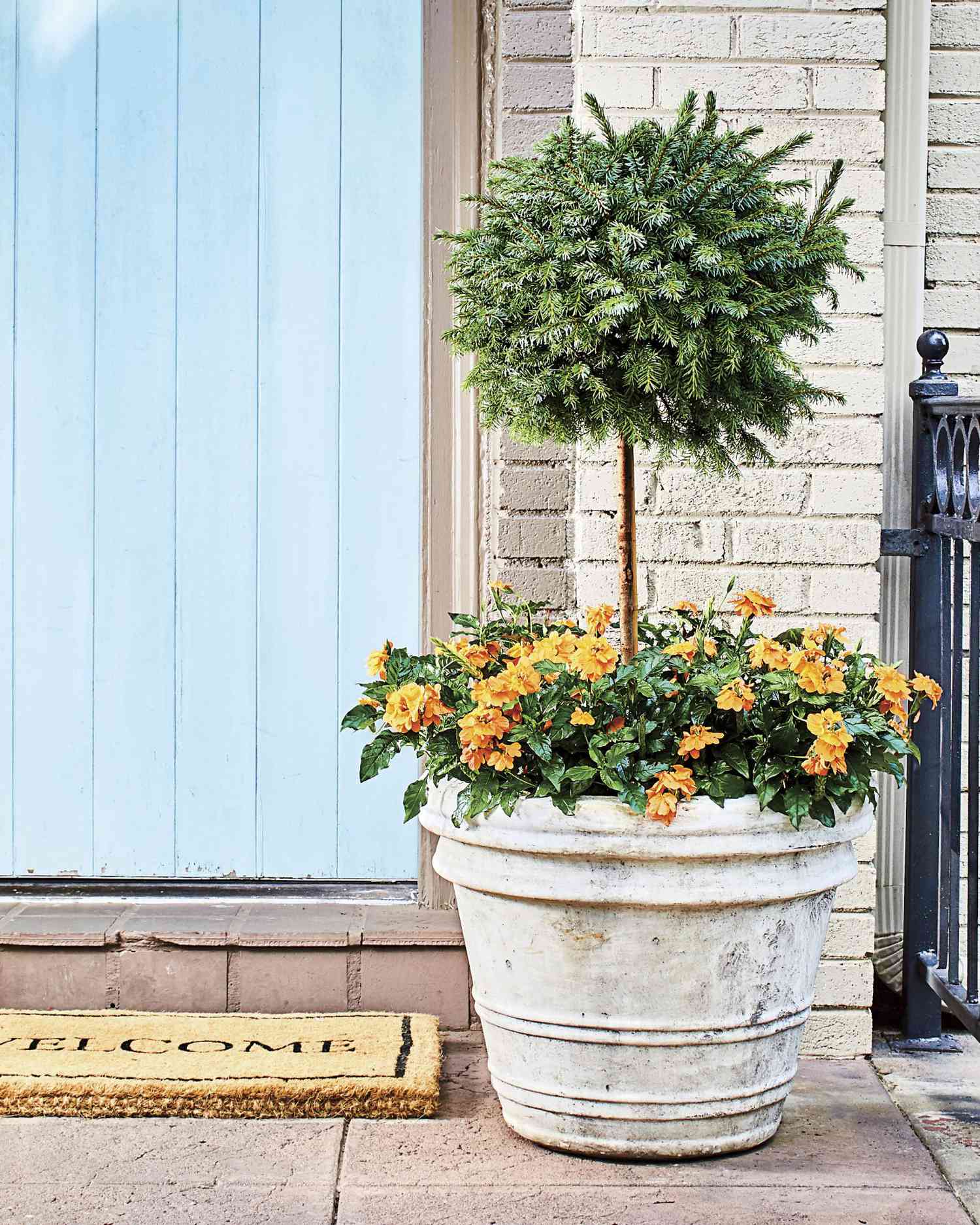
An evergreen topiary like this ball-form spruce is also a hard worker, going strong through fall and winter. Pair it with the «Orange Marmalade» firecracker flower, and it will feel at home on the porch during the changing seasons. The firecracker flower (Crossandra infundibuliformis) is an MVP through early fall as its colorful spikes continue to shine even when most other summer flowers are dying off. If your area gets a final heat wave, the firecracker flower will take it in stride as long as you keep it watered.
Plan For Endless Color
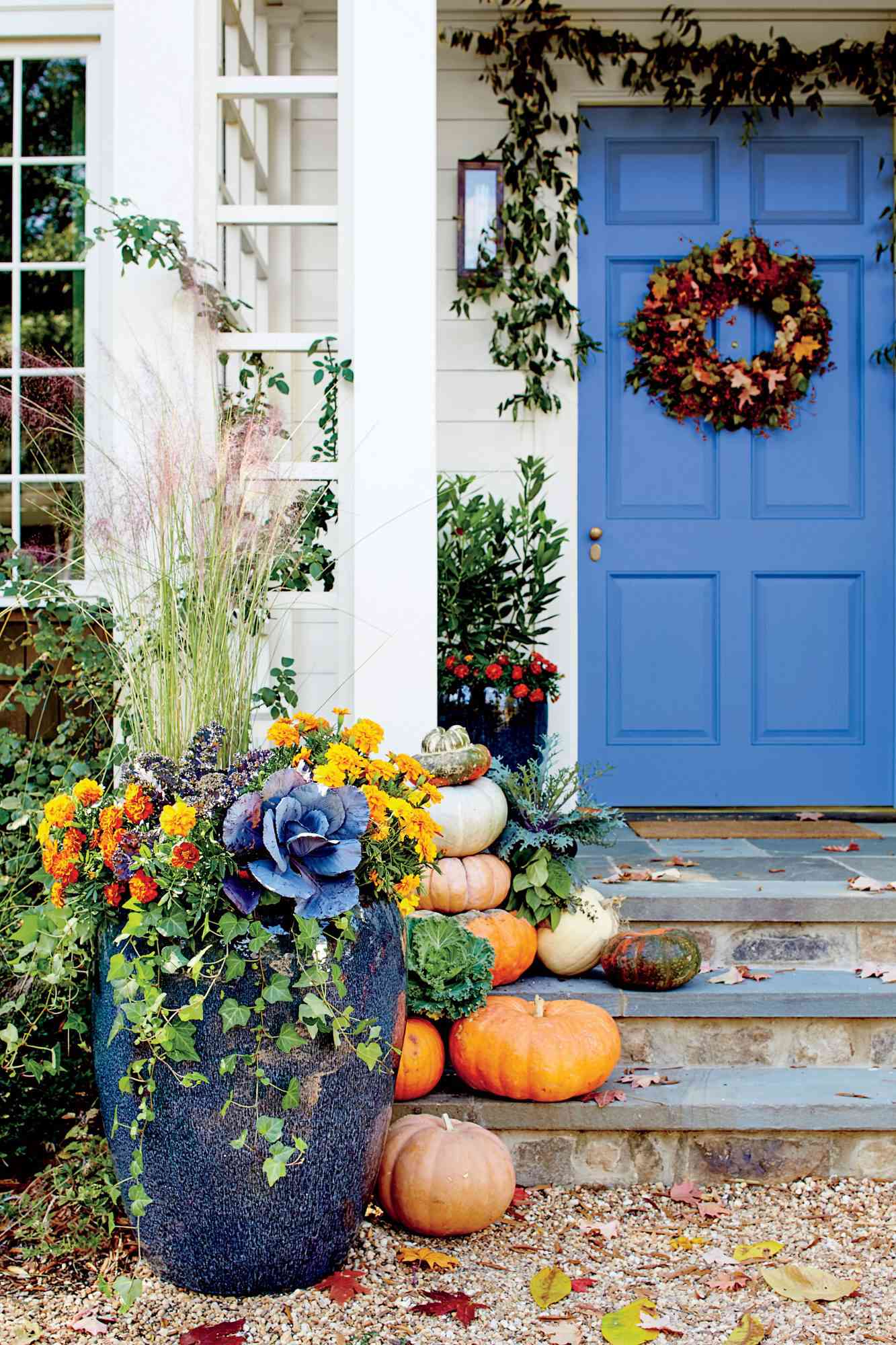
Marigolds and grasses make a magnificent summer-to-fall transition. Plant variegated sweet flag in the center, and surround it with alternating plantings of ornamental cabbage and marigolds. Fill in the outer edges with ivy, allowing it to spill over the sides. Water regularly, particularly if the sweet flag and ivy are sitting in direct light. The flowers love full sunlight and will provide color for a long time (even until the first frost) if you remove dried blooms throughout the season.
Reserve A Spot For Japanese Anemone
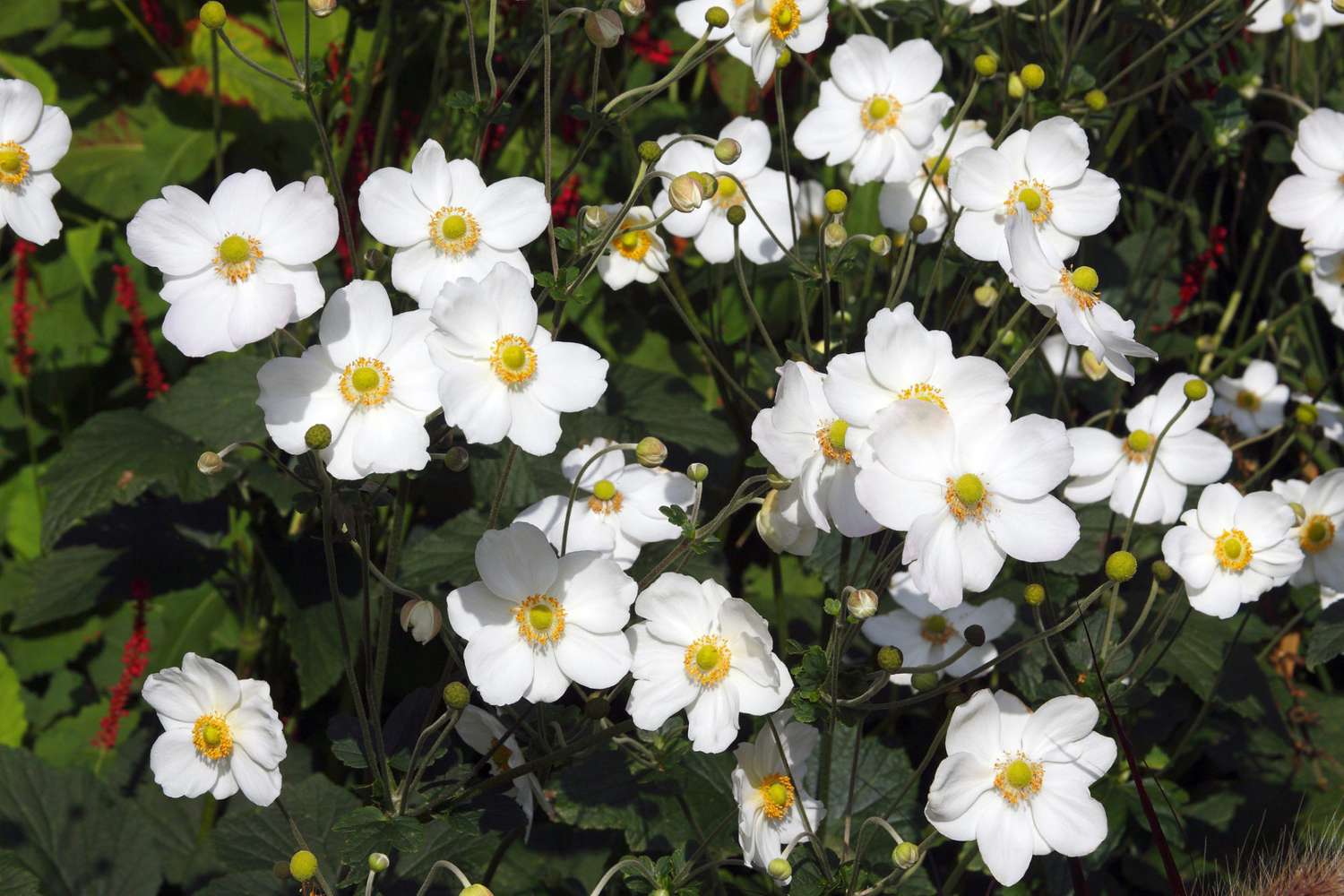
Japanese anemone (Anemone x hybrida) deserves to have a corner of your garden where it can lie in wait until fall, when the windflowers emerge on delicate stems above the foliage. In the South, plant them in USDA Plant Hardiness Zones 6-8 in rich soil and partial shade, where they will return year after year to delight you.
Plant A Patch Of Goldenrod
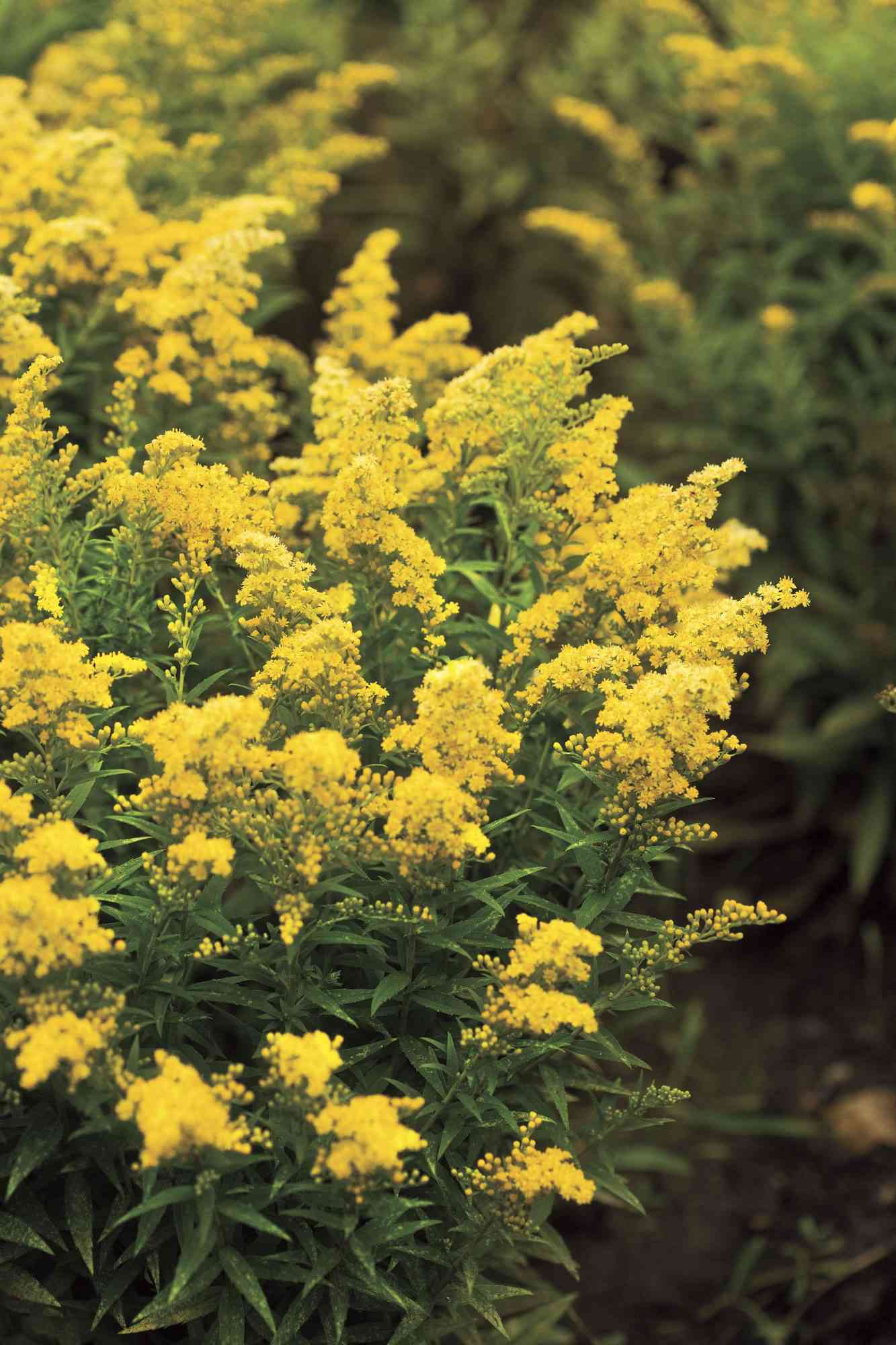
Goldenrod’s bright flowers are a beacon to bees in the autumn. Plant a patch of this tough perennial in the back of the border and it should bloom for weeks on end without any help from you. Goldenrod has a reputation for spreading aggressively, but garden center varieties like «Fireworks» (Solidago rugosa «Fireworks») are better behaved. Most will grow in zones 8 and cooler.
Admire The Toad Lily
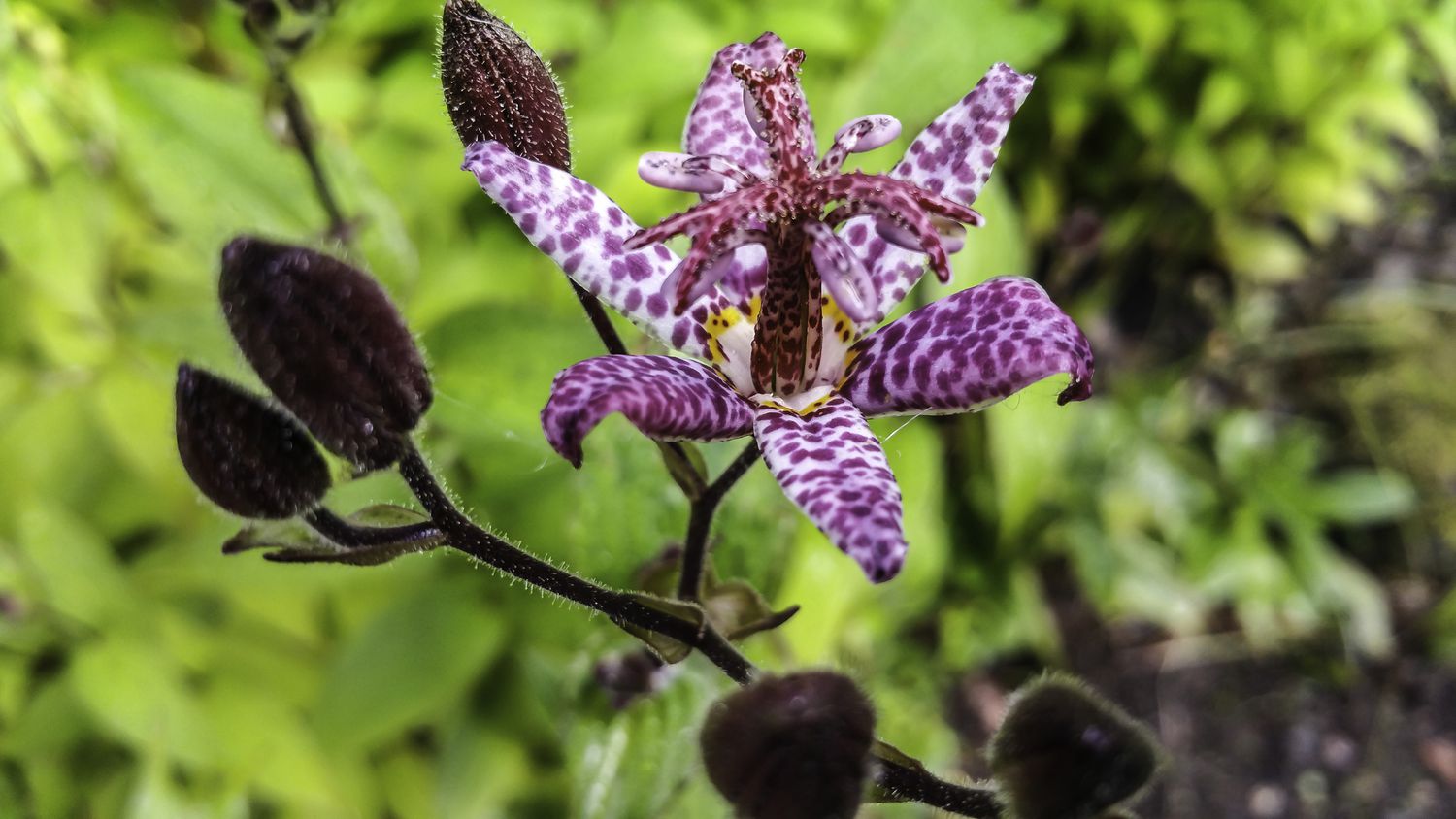
Perennial toad lilies (Tricyrtis spp.) are a spectacular autumn bloomer that can be grown in zones 9 and cooler. The flecked, orchid-like flowers are best appreciated up close, so plant these beauties in the front of a border where you can admire them from nearby. Toad lilies appreciate rich, well-drained, moist soil in partial shade.
Make Room For Fall Camellias
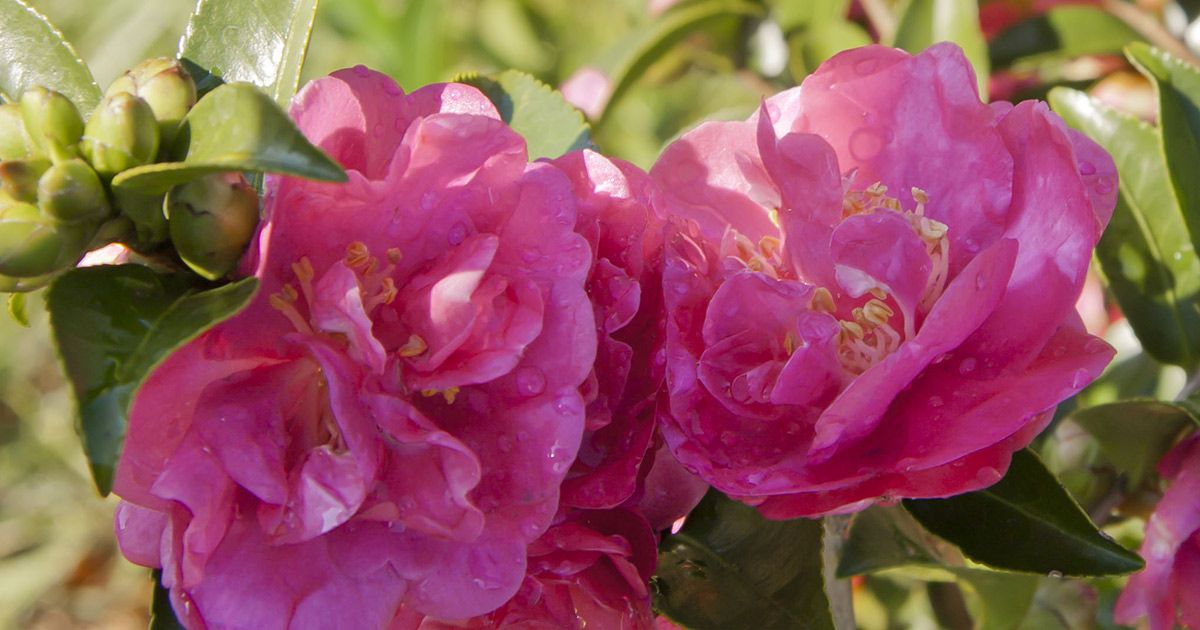
No list of fall-blooming plants is complete without the South’s most well-loved shrub, the camellia. Camellias can bloom anytime from fall to late winter, so choose one that is in flower or reference our list of favorite fall camellias. Plant camellias in zones 7-9 in light shade and rich, well-drained soil.
Make A Statement With Joe Pye-Weed
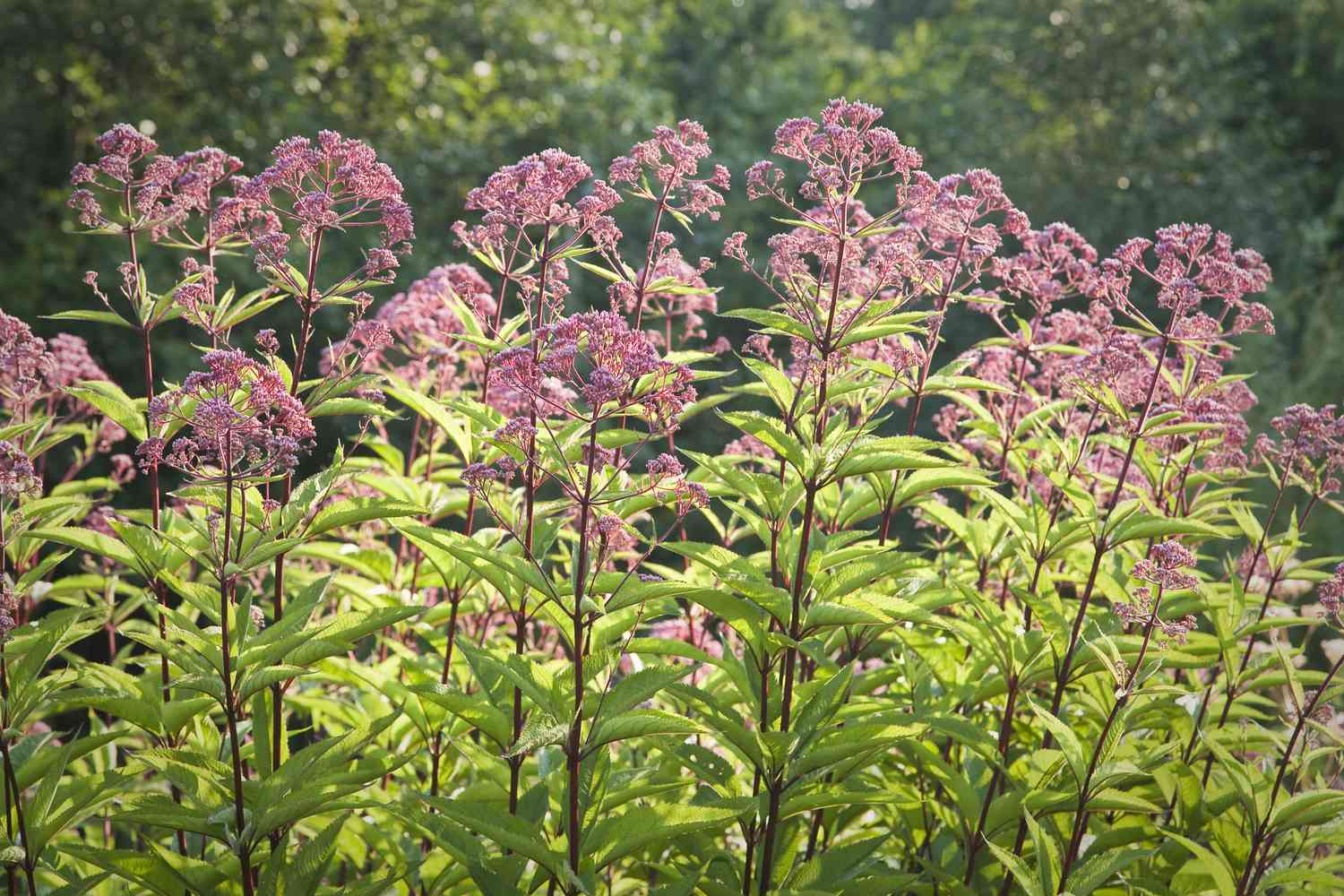
Native Joe Pye-weed (Eutrochium spp.) sets a dramatic backdrop in the fall garden. If you’re not looking for a 6 foot plant, there are more compact varieties like «Little Joe» to choose from. This pollinator plant can be grown as far south as zone 9, preferably in moist soil in full or partial sun.
Grow Remarkable Red Sage
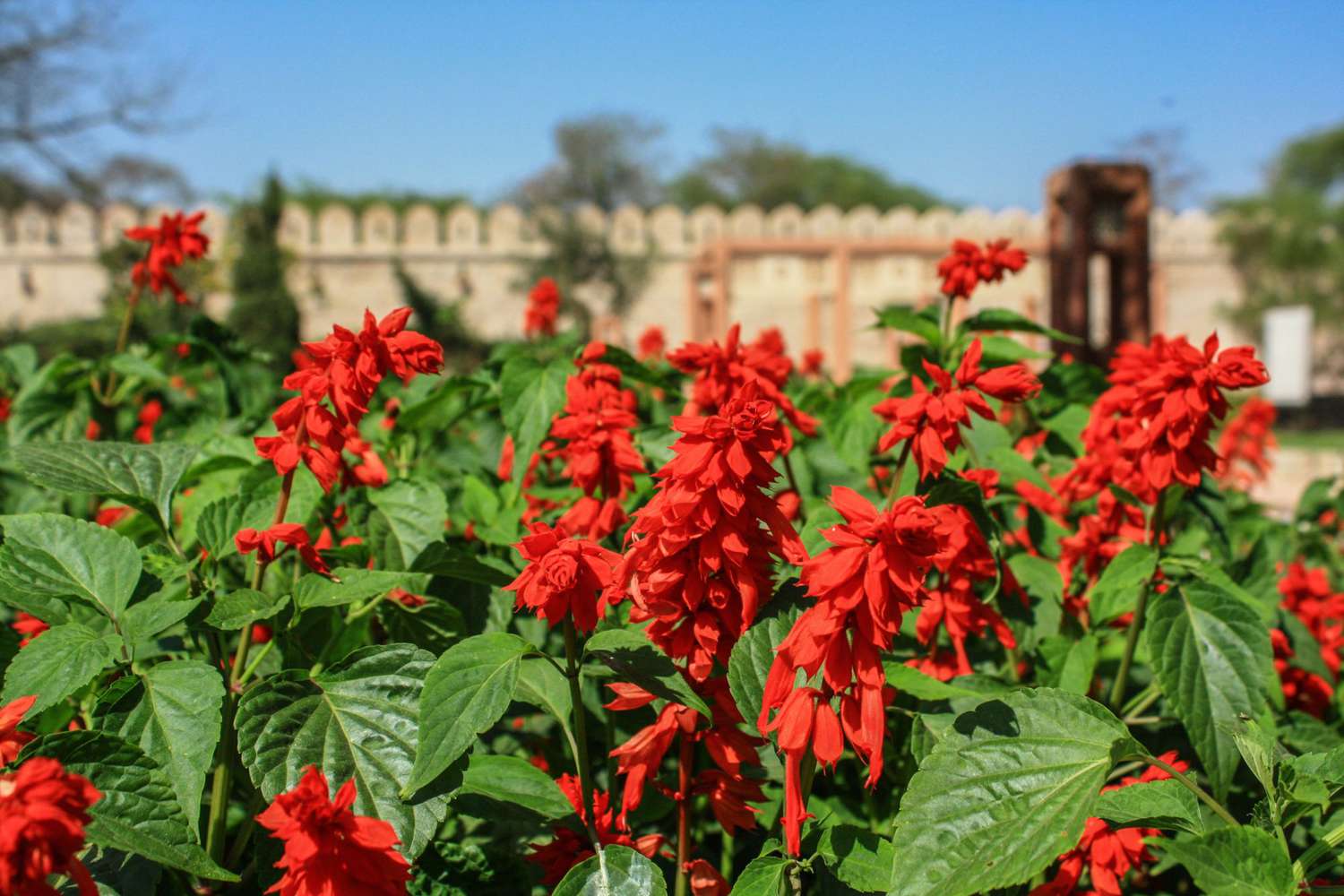
Intensely brilliant and utterly show-stopping until the first frost, red or scarlet sage (Salvia coccinea) is here to stay in your garden. Red sage can be planted in containers or along a flower border, where it will even grow year-round in a frost-free climate. Most gardeners plant it in full sun as an annual and enjoy it along with the hummingbirds and butterflies.
Fill Beds With Globe Amaranth

Globe amaranth (Gomphrena globosa) is a popular bedding flower because of its steadfastness in hot summers. Usually grown as an annual, gomphrena will continue blooming into the fall. This cutting flower has the added benefit of retaining its color when dried, so you can use it in your fall flower arrangements.
Was this page helpful?
Thanks for your feedback!
Tell us why!
Sources
Southern Living is committed to using high-quality, reputable sources to support the facts in our articles. Read our editorial guidelines to learn more about how we fact check our content for accuracy.
- University of Wisconsin-Madison, Wisconsin Horticulture. Autumn crocus.